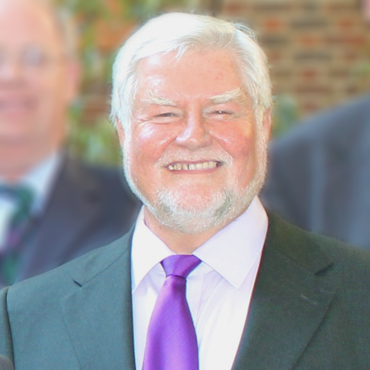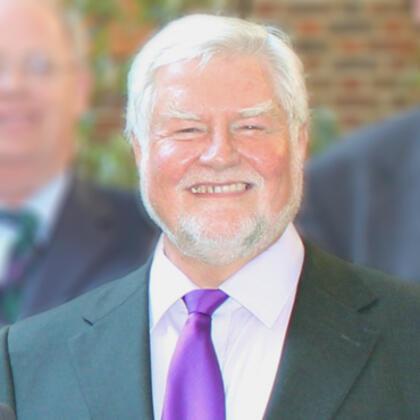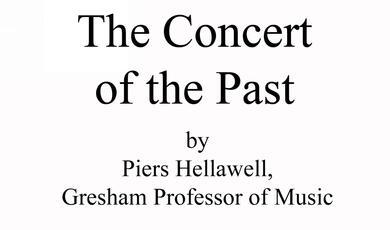Soothing the Savage Breast
Share
- Details
- Transcript
- Audio
- Downloads
- Extra Reading
Can music heal? For centuries its therapeutic virtues have been extolled. The various uses to which it is put are described and the scientific studies that evaluate its benefits. The possibility of music having socially damaging effects is also considered.
This is part of Professor Wilson's series of lectures for 2011/12. The other lectures are:
The Pursuit of Happiness
The Psychology of Politics
Mad, bad or sad?
Whatever turns you on?
Profiling a Killer
Download Transcript
Soothing the savage breast
Professor Glenn Wilson
Visiting Gresham Professor of Psychology
“Musick has charms to soothe the savage breast
To soften rocks, or bend a knotted oak”.
William Congreve(The Mourning Bride, 1697)
Music has been extolled for it’s healing powers since antiquity. Many cultures have invested it with spiritual, even cosmological, significance. The Egyptians called it “the word of the Gods”, Greeks referred to “the music of the spheres” and the Chinese described “the celestial energies of perfect harmony”. Apollo was the Greek God of both music and healing (among other things) and his agent Orpheus used music therapeutically. Centuries later, music was used in the treatment of King Phillip V of Spain, Ludwig II of Bavaria, and George III of England (Biley, 2000).
The connection between mood and the musical term “mode” is no accident. Music influences our emotions powerfully and has many medical applications (Aldridge, 1993). It is said to calm people undergoing medical procedures, assist with pain management in dentistry and hospice care, bolster the immune system, improve fluency in people with speech disorders, motivate people with motor disorders, revive pleasant memories and improve mood in the elderly and enhance quality of life in general. It can put babies to sleep, increase productivity in factories and reduce vandalism at railway stations. But music may be used for ill as well as good. It can drive unwilling soldiers into battle, sell groceries at a supermarket that we don’t really need, break down sexual inhibitions and provoke anti-police violence. Certain types of music possibly promote depression and even suicide.
When we describe music as “moving”, this may be literally true. Few people can listen to Anything Goes without their feet beginning to tap a little, and clinically it has been found that some patients who are virtually paralysed can be prompted to walk by rhythmic music. Comedian Terry Thomas reported that in the latter stages of Parkinson’s disease he could not walk through a door but could dance through it. “Singing” approaches to the treatment of stammering no doubt make use of a similar mechanism.
The motivational effect of music arises from the pacing (entrainment) of physiological rhythms, such as heart rate, blood pressure, respiration, brain waves and the muscle activity involved in the walking gait. The experience of the mother’s heartbeat in utero may be prototypic of adult rhythms; those around 72bpm are soothing, while those that accelerate beyond 80bpm tend to be arousing. Slow, regular rhythms (especially in a major key) are relaxing, while jerky, irregular ones are exciting. Soft music is more relaxing than loud, dissonant music. Repetitive rhythms may resonate in the brain so as to create trance-like conditions, with effects varying from dissociation to loss of control and convulsions. According to the cultural context, these may be variously interpreted as hysteria, fanaticism, possession or religious ecstasy.
Spectrographic analysis of music patterns across cultures reveals similar patterns in tone and tempo for lullabies, war songs, mourning songs, love songs and joyful music. Joyful music tends to be upbeat and energetic, with rising melodic phrases while sad music features minor keys and descending phrases. Dissonance is recognised in all societies and babies as young as four months react negatively to it. Such cross-cultural uniformities suggest that the effects of music are partly innate (Wilson, 2002).
Music influences non-humans as well. Dogs in an animal shelter have been shown to be soothed by classical music (more time spent quiet and resting), whereas heavy metal leads to more time barking (Wells et al, 2002). Other studies have found that milk yields in dairy cows are increased with slow (as compared with fast) tempo music and that rats exposed to stress-inducing rock music are slower to heal (North & Hargreaves, 2009).
Brain scan studies confirm that when people experience “chills” (“frissons”) through listening to their favourite selections, dopamine is released in the mesolimbic reward system (Salimpoor, 2011). Activation of these reward systems seems to be diminished in people suffering from depression (Osuch et al, 2009).
Music may be useful in pain control in palliative care, dentistry and surgery (Good et al, 2002; Curtis, 2011). However the benefit is most reliably observed in self-report and is not always matched by reductions in levels of self-administered medication. Where benefits are observed, these may be due to distraction, relaxation, a feeling of control or secretion of dopamine/endorphins.
The impact of mood-enhancing and stress-reducing music on stress hormones and the immune system has been documented. Reduction in cortisol, increased DHEA, improved coherence in the autonomic nervous system, and potentiation of secretory immunoglobin have been observed in both healthy subjects and individuals with clinical conditions such as anxiety, depression, panic, arrhythmias, diabetes and chronic fatigue (McCraty 1999).
Classical music affects cardiovascular variables (Bernardi et al, 2009). Vocal and orchestral crescendos increase blood pressure while slower passages decrease it. This applies equally to musicians and non-musicians. Reviewing the effects of music on cardiovascular health, Trappe (2010) concluded that relaxing music lowered anxiety in pre-operative settings on various physiological indicators and was a useful alternative to midazolam for premedication. Following open heart surgery, patients benefited from listening to classical and meditational music whereas heavy metal and techno music were not only ineffective but potentially dangerous.
The emotional impact of music is just as important as tempo and volume. Researchers at the University of Maryland Medical Centre studied the effects of music on the circulation of the blood, an index linked to cardiovascular risk. They had volunteers select musical pieces that made them feel personally joyful, as well as others that made them anxious, and compared arterial blood flow while they listened to these two types. Circulation improved by 26% with joyful music but fell 6% with anxious music (Miller et al, 2008). In another study, neurological patients with visual neglect showed enhanced visual awareness when tasks were performed with preferred (pleasant) music than with either non-preferred music or silence (Soto et al, 2009).
Why do people like sad music? Perhaps it offers a kind of empathy – the reassurance that others understand what they are suffering. Certainly, it is simple-minded to suppose that depressed or terminally ill people need to be “jollied up” by music. Validation of their own mood may be more appropriate. Huron (2011) believes that sorrowful music releases the hormone prolactin (associated mainly with motherhood but also giving feelings of consolation). Since with sad music the grief is recognised cortically as not real, the build up of prolactin produces feelings of pleasure. Huron suggests that nostalgic music may be connected with secretion of the bonding hormone oxytocin.
Music is an important component of reminiscence therapy for older people - restimulating happy memories from the past and creating a sense of familiarity and security. Similar connections may account for instances of people being revived from long-term coma with music of deeply personal significance. Coma patients are more likely to be contacted by music than speech (Aldridge et al, 1990).
Using fMRI scans, Petr Janata at U.C. Davis (2009) has identified an area in the dorsomedial prefrontal cortex (DMPC) that connects familiar music, memory for salient life events, and emotions like joy and sadness. The music seems to serve as a soundtrack for a movie that is played in the head, recalling past episodes that arouse strong feelings. Since this nostalgia hub is one of the last areas of the brain to atrophy in dementia this might account for the fact that Alzheimer’s patients continue to respond to music well into their illness.
The Mozart Effect, as first described in the 1990s, was an enhanced performance on spatial reasoning tasks after listening to Mozart’s music (particularly K.448, Sonata for Two Pianos in D major, a fast tempo, highly structured piece of music). This has not been consistently replicated but a more robust finding is that K.448 reduces the frequency of epileptic seizures in susceptible children (after listening for 8 minutes before bedtime). The effect seems to last for at least 6 months (Lin et al, 2011). This may not be unique to Mozart: a piece of music found to have a similar effect is Acroyali/Standing in motion, by Greek-American composer Yanni. This has similar energy, tempo, consonance, structure and predictability to K.448.
A study by Husain et al (2002) sheds light on how the Mozart effect, when observed, might work. They generated a faster than normal K.448 (+35%) and a slower than normal one (half-speed). They also had both versions transposed into the minor key. Cognitive performance was best after the faster/major mode version. Apparently, the speed altered feelings of arousal, while the mode affected mood (more negative with the minor). The authors concluded that performance was maximised when the music made people feel aroused and positive.
Music therapy is fast developing as a specialist profession. Those trained in the Nordoff and Robbins (1977) tradition favour one-on-one work, mainly with disabled or disturbed children. Treatment is geared to the needs of the individual but often takes the form of some kind of improvised dialogue using instrumental or vocal sound rather than words (c.f., the Duelling Banjos scene in the film Deliverance). Again, the theory is that the musical channel of communication may be open where speech is perfunctory or absent. Evidence for its value depends mostly on case reports but there are impressive studies using video analysis to reveal improvement over time in indices such as vocalisation, looking behaviour, imitation and initiation of ideas (Bunt 1997). At the very least, there is the satisfaction of expressing emotions, exercising skills and cooperating with other people.
Vibroacoustic therapy refers to the idea that musical vibrations can be delivered direct to the body as well as through hearing. Various devices have been developed for this purpose, including mats, chairs and baths. With one such “music bath”, sufferers of conditions such as cerebral palsy, arthritis, asthma, back pain or circulatory problems lie in a bed of speakers enveloped by soothing sound and vibrations. This is said to produce deep relaxation and has found wider applications, such as post-sport relaxation for skiers and runners and stress reduction for business executives (Wigram et al 1995). A patent bath that combines sound and vibration delivered through water (as well as light patterns) has also been developed. While usually enjoyed by clients, scientific validation of these procedures is scanty (Kvam, 1997).
Many reports on the benefits of music therapy consist of uncontrolled clinical case studies. Others apply so-called “qualitative research” methods which fall short of the usual standards of scientific methodology and data analysis. Frequently, they suffer from the problem that the person delivering the therapy is also the one evaluating it, which obviously opens itself to bias (Aigen, 2008).
The gold standards for evaluating a treatment are the randomised controlled trial (RCT) and meta-analysis. These are geared primarily to drug treatments and are not easily applied to humanistic therapies because of variations in client types, details of procedure and lack of agreement concerning precise outcome. Nevertheless, some consistent findings have emerged (Edwards, 2005). Meta-analysis of music in medical treatment shows that effect sizes are greater for women (.90) than for men (.57). They are also greater for children and adolescents (.95) than adults (.87), while infants show the lowest effect sizes (.48).
In a meta-analysis of the use of music interventions to alleviate symptoms and treatment side-effects in cancer patients, Bradt et al (2011) confirmed beneficial effects on anxiety, blood pressure, pain, mood and quality of life. However, they were not able to detect any improvement with respect to fatigue or physical status and conclusions were tentative because many of the trials were at risk of bias. No significant difference was observed between interventions delivered by trained music therapists and listening to pre-recorded music supervised by medical staff. However, live music performances in hospices may benefit from the added personal touch of the performer (Lindsay, 1991).
Even when a study appears to be randomly controlled it may be difficult to know whether the control is appropriate. For example, Hanser & Thompson (1994) divided older adults diagnosed with depression into three groups. One was given a home-based programme of music-listening stress reduction guided by weekly visits from a music therapist. The second group followed a self-administered programme backed up by a weekly phone call from the therapist. The third group was a wait-list control. Both music groups showed improvement in self-esteem and mood compared with controls. This was taken as support for musical interventions for home-bound elders and indeed it might be, except that we don’t know to what extent the feeling that help was being given was the agent of therapy rather than any specific musical content.
A better example of a controlled study showing a therapeutic effect of music is that of Sarkamo et al (2008) with patients in early stages of stroke recovery. Those who listened daily to self-selected music showed greater improvement than those listening to audio books or not listening to anything. Improvements in verbal memory, focussed attention, confusion and mood were all greater in the music listening group than either of the two controls. The authors concluded that music should be offered to stroke patients in addition to other forms of active therapy.
The benefits of music are not just in the listening. Interactive performance has additional benefits. Singing, for example, has been shown to result in respiratory and cardiovascular enhancement similar to that provided by aerobic exercise and has been specifically recommended in patients suffering from chronic obstructive pulmonary disease (Bonhila et al, 2009). Improvements in neurological functioning have been observed along with strengthening of the immune system (Beck et al, 2000) and benefits have been found with respect to mood, self-concept and social communication (Welch, 2007).
Music preferences are a source of social bonding. Musical taste is a marker of attitudes and values and we are attracted to other people who share our values (Boer et al, 2011). This is why items about musical preferences are contained in standard partner compatibility questionnaires, such as the Compatibility Quotient (Wilson & Cousins, 2005).
We have noted that rock music might be detrimental to cardiovascular patients. Could it also be responsible for increased violence and the breakdown of moral restraint in society. Research addressing this issue suggests that the destructive themes of rock lyrics generally reflect social mores rather than precede them (Wilson, 2002). A prime function of pop music is to crystallise teenage rebellion against the parental generation. Pop stars throughout history have outraged public decency in their time but seem like pantomime villains in retrospect.
In 1985, British rock band Judas Priest was put on trail in Reno, Nevada, accused of inducing a suicide pact between two unstable, drug-using young men. Although they were (no doubt rightly) acquitted, there are studies showing a relationship between interest in heavy metal rock, rap and suicide. However, the thoughts of self-harm seem to precede the interest in rock, so it is likely that the connection between suicide and rock music is mediated by family background and self-esteem (North & Hargreaves, 2009).
Sociologists Stack & Gundlach (1992) reported a connection between the amount of airtime devoted to country music and suicide rates across 49 metropolitan areas in the U.S. This effect was unconnected with divorce, poverty, gun availability, and southernness. The authors concluded that the recurrent themes of country music, which stress problems such as alcohol abuse and marital strife, may promote suicide by nurturing a pre-existing self-destructive mood.
While it is understandable that people averse to country music might be driven to suicide by excessive exposure to it, it is more surprising that those who choose to listen to it (and hence presumably enjoy it) are sometimes prompted to end their life. Perhaps, after all, we are safest to adopt the position of Jimmy Durante who once said: “I hate music – especially when its played”. He lived to a ripe old age.
Despite these caveats, music is generally beneficial in medical contexts. It can directly enhance mood, bolster immunity, energise people, revive pleasant memories or distract from unpleasant realities. It can contribute to health and well-being by offering an alternative, non-verbal channel of communication. Since verbal skills are mostly used to assess mental competence (e.g., in assigning children to special homes or older people to geriatric wards) there is a danger that people who are musically competent are submerged in what, for them, is an impoverished or alien environment. In these days of relentless dumbing down this is a problem we ought to be concerned about.
References
Aigen, K. (2008) An analysis of qualitative music therapy research reports 1987-2006: Articles and book chapters. The Arts in Psychotherapy,35, 251-261.
Aldridge, D. et al (1990) Where am I? Music therapy applied to coma patients. Journal of the Royal Society of Medicine, 83, 345-346.
Aldridge, D. (1995) Music therapy research I: A review of the medical research literature within a general context of music therapy research. The Arts in Psychotherapy, 20, 11-35.
Beck, R.J. et al (2000) Choral singing, performance perception and immune system changes in salivary immunoglobulin A and cortisol. Music Perception, 18, 87-106.
Bernardi, L. et al (2009) Dynamic interactions between musical, cardiovascular, and cerebral rhythms in humans. Circulation, 119, 3171-3180.
Biley, F.C. (2000) The effect on patient well-being of music listening as a nursing intervention: A review of the literature. Journal of Clinical Nursing, 9, 668-677.
Boer, D. et al (2011) How shared preferences in music create bonds between people: Values as the missing link. Personality and Social Psychology Bulletin, online.
Bonhila, A.G. et al (2009) Effects of singing classes on pulmonary function and quality of life of COPD patients. International Journal of Chronic Obstructive Pulmonary Disease, 4, 1-8.
Bradt, J. et al (2011) Music interventions for improving psychological and physical outcomes in cancer patients. The Cochrane Collaboration. John Wiley.
Bunt, L. (1997) Clinical and therapeutic uses of music. In D.J. Hargreaves & A.C. North (Eds) The Social Psychology of Music. Oxford University Press.
Curtis, S.L. (2011) Music therapy and the symphony: A university-community collaborative project in palliative care. Music and Medicine, 3, 20-26.
Edwards, J. (2005) Possibilities and problems for evidence-based practice in music therapy. The Arts in Psychotherapy, 32, 293-301.
Good, M. et al (2002) Relaxation and music reduce pain after gynaecologic surgery. Pain Management Nursing, 3, 61-70.
Huron, D. (2011) Why is sad music pleasurable? A possible role for prolactin. Musicae Scientiae, 15, 146-158.
Janata, P. (2009) The neural architecture of music-evoked autobiographical memories. Cerebral Cortex, 19, 2579-2594.
Lin, L.C. et al (2011) The long-term effect of listening to Mozart K.448 decreases epileptiform discharges in children with epilepsy. Epilepsy and Behaviour, 2011, 21, 420-424.
Lindsay, S. (1991) Live music in hospitals. In G.D.Wilson (Ed.) Psychology and Performing Arts. Amsterdam: Swets & Zeitlinger.
Osuch, E. et al (2009). Brain activation to favourite music in healthy controls and depressed patients. NeuroReport, 20, 1204-1208.
Hanser, S.B. & Thompson, L.W. (1994) Effects of a music therapy strategy on depressed older patients. Journal of Gerontology, 49, 265-269.
Kvam, M.H. (1997) The effect of vibroacoustic therapy. Physiotherapy, 83, 290-295.
McCraty, R.(1999) Music and the immune system. Proceedings of the Tenth International Congress on Stress. Montreux, Switzerland.
Miller, M. et al (2008) Positive emotions and the endothelium: Does joyful music improve musical health? Circulation, 118:S.1148.
Nordoff, P. & Robbins, C. (1977) Creative Music Therapy. New York: John Day.
North, A.C. & Hargreaves, D.J. (2009) The power of music. The Psychologist, 22, 1012-1013.
Salimpoor, V. et al (2011) Anatomically distinct dopamine release during anticipation and experience of peak emotion to music. Nature Neuroscience, 14, 257-262.
Sarkomo, T. et al (2008) Music listening enhances cognitive recovery and mood after middle cerebral artery stroke. Brain, 131, 866-876.
Soto, D. et al (2009) Pleasant music overcomes the loss of awareness in patients with visual neglect. Proceedings of the National Academy of Sciences, 106, 6011-6016.
Stack, S. & Gundlach, J. (1992) The effect of country music on suicide. Social Forces, 71, 211-218.
Trappe, H. et al (2010) The effects of music on the cardiovascular system and cardiovascular health. Heart, 96, 1868-1871.
Welch, G.F. (2007) The benefits of singing – an overview. Institute of Education, University of London (web letter).
Wells, D.L. et al (2002) The influence of auditory stimulation on the behaviour of dogs housed in a rescue shelter. Animal Welfare,11, 385-393.
Wigram, T. Saperston, B. and West, R (Eds) (1995) The Art and Science of Music Therapy: A handbook. Harwood Academic Publishers, Langhorne.
Wilson, G.D. (2002) Psychology for Performing Artists. London: Whurr.
Wilson, G.D. & Cousins, J.M. (2005) Measurement of partner compatibility: Further validation and refinement of the CQ test. Sexual and RelationshipTherapy, 20, 421-429.
©Professor Glenn Wilson, Gresham College 2011
This event was on Tue, 04 Oct 2011
Support Gresham
Gresham College has offered an outstanding education to the public free of charge for over 400 years. Today, Gresham plays an important role in fostering a love of learning and a greater understanding of ourselves and the world around us. Your donation will help to widen our reach and to broaden our audience, allowing more people to benefit from a high-quality education from some of the brightest minds.


 Login
Login







